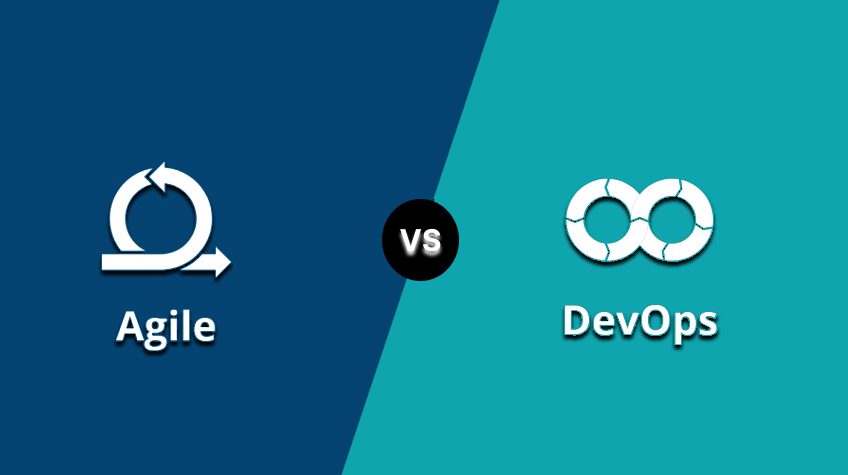
Welcome to our blog, where we embark on an exciting journey to explore the key differences and benefits of Agile and DevOps methodologies. In software development, these two approaches have made significant waves, revolutionizing how teams deliver value to customers. With its flexibility and customer-centric focus, Agile dances with adaptability, while DevOps orchestrates a harmonious collaboration between development and operations.
Join us as we delve into the intricacies of Agile and DevOps, uncover their unique characteristics, and discover how embracing both can unlock a world of efficiency, innovation, and success in today’s fast-paced software development landscape. In this blog, we go through Agile Vs. DevOps: understanding the key differences and benefits.
What is Agile
Agile is like the heartbeat of modern software development, pulsing with flexibility and adaptability. It’s a dynamic approach that embraces change rather than shying away. Imagine a team of skilled musicians jamming together, each playing their unique instrument harmoniously.
Similarly, Agile assembles cross-functional teams united in pursuit of a common goal, with each member contributing their expertise. It’s all about breaking down projects into manageable chunks called sprints, like taking one step at a time to climb a mountain—customer collaboration and feedback fuel its engine, driving continuous improvement. Agile is the rhythm that keeps software development dancing to the tune of progress.
What is DevOps
DevOps is the perfect harmony between development and operations in the symphony of software delivery. It’s like a well-choreographed dance routine in which developers and operations professionals collaborate seamlessly. DevOps eliminates silos and encourages collaboration, creating a shared responsibility and ownership culture. It’s about automating repetitive tasks and orchestrating a smooth code flow from development to deployment.
Picture a synchronized team effortlessly balancing speed and stability, like tightrope walkers on a high wire. With continuous integration, continuous delivery, and continuous feedback, DevOps aims to deliver quality software rapidly while ensuring the reliability and resilience of the final performance.
Agile Methodology
⁍ Definition and Principles
Agile methodology is an enthusiastic and customer-focused approach to software development that thrives on adaptability and collaboration. It’s like a compass that guides teams through the ever-changing landscape of project requirements. At its core, Agile embraces the values and principles of the Agile Manifesto, emphasizing individuals and interactions over rigid processes and valuing working software over extensive documentation.
It encourages frequent customer collaboration and feedback, empowering teams to respond swiftly to evolving needs. Agile’s iterative and incremental nature allows for continuous improvement, fostering a sense of shared ownership and transparency. It’s the art of crafting software with agility, precision, and a touch of creativity.
⁍ Key Characteristics
Agile methodology embodies several vital characteristics contributing to its software development effectiveness. Firstly, user stories and product backlogs serve as guiding lights, capturing customer requirements concisely and understandably. They bring the customer’s voice to the forefront, ensuring the development team stays aligned with their needs.
The concept of sprints and time-boxed iterations injects a sense of rhythm and structure into Agile. Sprints are like mini marathons, where the team commits to completing prioritized tasks within a fixed timeframe. This time-bound approach fosters focus and efficiency, promoting regular deliverables and feedback loops.
Crucially, Agile values cross-functional teams and collaboration. Agile enables effective solution-finding and decision-making by getting together people with diverse skills and expertise. Team members collaborate closely, sharing knowledge, breaking down silos, and collectively working towards a common goal. This collaborative spirit amplifies creativity and innovation, leading to higher-quality software solutions.
⁍ Benefits of Agile
The agile methodology brings forth a treasure trove of benefits that elevate the software development process. Firstly, it imbues projects with a remarkable level of flexibility and adaptability. Agile embraces change as a natural part of development, allowing teams to pivot and adjust to evolving requirements without losing momentum.
Enhanced customer satisfaction is another jewel in Agile’s crown. Agile ensures customer expectations are continuously met and exceeded through regular feedback loops. By involving customers throughout the development cycle, Agile fosters a deeper understanding of their needs, resulting in solutions that resonate with them.
Agile is a vigilant guardian, enabling early detection and mitigation of project risks. Its iterative nature allows for frequent inspection and adaptation, catching potential issues before they snowball into major problems.
Furthermore, Agile paves the way for improved team collaboration and communication. With its emphasis on cross-functional teams and close cooperation, Agile creates an environment where ideas flow freely, enhancing creativity and problem-solving abilities. Effective communication channels ensure everyone is on the same page, promoting a shared sense of purpose and unity within the team.
DevOps Methodology
⁍ Definition and Principles
DevOps methodology is a harmonious fusion of development and operations, orchestrating a seamless symphony in software delivery. It emerged as a response to the need for closer collaboration between these traditionally separate teams. DevOps breaks down the barriers and encourages cross-functional collaboration, enabling a shared understanding of goals and responsibilities.
DevOps’s heart lies in a deep commitment to automation and continuous delivery. It’s like having a well-oiled machine where repetitive tasks are automated, allowing teams time to focus on innovation and value creation.
DevOps advocates for a smooth code flow from development to deployment, promoting frequent releases and rapid feedback cycles. With automation as its guiding principle, DevOps unlocks the door to increased efficiency, faster time-to-market, and enhanced customer satisfaction.
⁍ Key Characteristics
DevOps methodology embraces key characteristics that amplify its effectiveness in modern software development. “Infrastructure as code” is a game-changing concept where infrastructure components, such as servers and networks, are provisioned and managed through code. It brings automation and consistency to infrastructure management, enabling teams to treat infrastructure as a programmable entity.
DevOps’ dynamic duo is Continuous integration and deployment (CI/CD). The continuous integration process ensures that code changes are regularly integrated into a shared repository, enabling early detection of conflicts or issues. The CD takes it further, automating the deployment process to swiftly and reliably deliver changes into production. The streamlined approach minimizes errors, shortens feedback cycles, and accelerates time-to-market.
Monitoring and feedback loops form the vigilant eyes and ears of DevOps. The ability to continuously monitor software systems gives teams the opportunity to detect issues and address them promptly, thus ensuring optimal performance and dependability. Feedback loops involving stakeholders and end-users provide valuable insights for further improvements. This iterative feedback process enhances software quality and fosters a customer-centric approach.
These characteristics empower DevOps teams to build robust and scalable software solutions, automate workflows, and deliver value with incredible speed and efficiency.
⁍ Benefits of DevOps
DevOps methodology unfurls a bouquet of benefits that transform the software development landscape. It ushers in faster and more frequent software releases, like a swift gust of wind propelling progress. By automating processes and removing bottlenecks, DevOps enables teams to deliver updates and features acceleratedly, keeping up with the ever-evolving market demands.
DevOps is the maestro of teamwork and coordination. Connecting development, operations, and other teams nurture a culture of shared responsibility and effective teamwork. This harmonious collaboration breaks down silos, fosters knowledge sharing, and unleashes collective creativity, resulting in more robust and innovative solutions.
Software systems’ stability and reliability are fortified under DevOps’s wings. Continuous monitoring, proactive testing, and automated deployments ensure that software remains resilient and reliable in production environments. This reliability builds user trust, enhances customer satisfaction, and minimizes disruptions.
DevOps is a master conductor for resource efficiency and reducing time-to-market. DevOps optimizes resource utilization and eliminates waste by leveraging automation, efficient use of infrastructure, and streamlined workflows. This efficient resource allocation translates into faster time-to-market, enabling organizations to capitalize on business opportunities quickly. to capitalize on business opportunities quickly. to capitalize on business opportunities quickly.
Agile Vs. DevOps
⁍ Key Differences Agile and DevOps
One of the key differences between Agile and DevOps lies in their scope and focus. Agile methodology primarily concentrates on the software development process. It emphasizes iterative development, customer collaboration, and delivering working software incrementally. Agile is centered around efficient and flexible development lifecycle management, ensuring customer satisfaction and adaptability to changing requirements.
On the other hand, DevOps takes a broader perspective, encompassing both the development and operations lifecycles. DevOps promotes seamless collaboration between development and operations teams, aiming to enhance the efficiency and reliability of software delivery. It emphasizes automation, continuous integration, and continuous deployment to achieve faster releases, higher quality, and improved overall performance. DevOps bridges the void between development and operations, creating an environment of shared responsibility and streamlining the end-to-end software delivery process.
⁍ Team Structure
When it comes to team structure, Agile and DevOps follow different paths. In Agile, cross-functional teams are at the core of the methodology. These teams consist of people with diverse talents and expertise, such as developers, testers, designers, and more. The team works together closely, guided by an owner who represents the customer’s interests and a Scrum Master who enables the Agile procedure. This structure promotes effective collaboration, knowledge sharing, and a collective ownership mindset.
In contrast, DevOps emphasizes collaboration not only between developers but also between operations teams and other stakeholders. Through it, silos are broken down and encourage open communication, fostering a culture of shared responsibility and continuous improvement. Developers work hand in hand with operations professionals to guarantee smooth software delivery and deployment.
The involvement of other stakeholders, such as quality assurance, security, and business teams, further strengthens the collaborative spirit of DevOps, fostering a holistic approach to software development and delivery.
⁍ Timeframe
Regarding the timeframe, Agile and DevOps operate on different rhythms. The agile methodology works in iterations or sprints, each with a fixed timeframe. The duration of these sprints is typically determined at the beginning of the project, focusing on delivering a specific set of features or user stories within that timeframe. The fixed timeframes provide a cadence to the development process, ensuring regular progress updates and opportunities for feedback and adjustment.
In contrast, DevOps is an ongoing and continuous process that does not adhere to specific fixed timeframes. It operates on a perpetual cycle of development, integration, testing, deployment, and monitoring. DevOps teams strive for continuous integration and delivery, where changes are deployed as soon as they are ready, often supported by automation. The absence of fixed timeframes allows for a more fluid and agile approach, facilitating faster and more frequent software releases.
⁍ Automation
Automation plays a distinct role in both Agile and DevOps methodologies. While automation can support development activities in Agile, it is generally less emphasized than DevOps. Agile teams may rely more on manual processes, such as manual testing or manual deployments, focusing on iterative development and customer collaboration.
On the other hand, automation is a cornerstone of DevOps. It is a fundamental aspect that enables the continued delivery and deployment of software. DevOps emphasizes automating repetitious tasks like code builds, testing, and deployments to streamline the software delivery process. DevOps automation helps eliminate human error, reduce lead time, enhance scalability, and ensure consistent deployment quality. It empowers units to achieve speedy, more trustworthy, and more efficient software releases.
Combined Benefits of Agile and DevOps
When Agile and DevOps are combined, they create a powerful synergy that enhances software development processes. Agile’s customer-centric approach and iterative development align perfectly with DevOps’ focus on collaboration and automation. By adopting both methodologies, organizations can achieve greater efficiency and productivity throughout the software delivery lifecycle.
Agile ensures that customer requirements are met through incremental development and regular feedback, while DevOps enables faster and more reliable deployment through automation and continuous delivery. Integrating Agile and DevOps fosters a culture of continuous improvement, collaboration, and adaptability, resulting in accelerated time-to-market, higher-quality software, and improved customer delight. It’s a winning formula for organizations seeking to flourish in today’s busy and striving environment.
In conclusion, Agile and DevOps are two influential methodologies in the software development world, each with distinct characteristics and benefits. Agile brings customer-centricity, adaptability, and iterative development to the forefront, while DevOps emphasizes collaboration, automation, and continuous delivery. Selecting the proper methodology depends on project requirements and goals. However, organizations embracing Agile and DevOps can experience a powerful synergy.
By combining their strengths, teams can achieve increased flexibility, faster time-to-market, improved collaboration, and enhanced customer satisfaction. In today’s rapidly evolving landscape, embracing the best of Agile and DevOps is a crucial driver for success and growth in software development. We hope this blog on Agile Vs. DevOps: understanding the key differences and benefits is useful to the readers.






